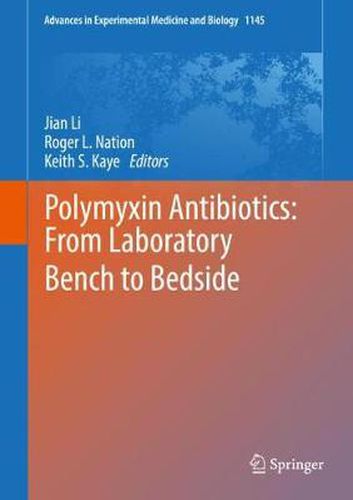Readings Newsletter
Become a Readings Member to make your shopping experience even easier.
Sign in or sign up for free!
You’re not far away from qualifying for FREE standard shipping within Australia
You’ve qualified for FREE standard shipping within Australia
The cart is loading…






This title is printed to order. This book may have been self-published. If so, we cannot guarantee the quality of the content. In the main most books will have gone through the editing process however some may not. We therefore suggest that you be aware of this before ordering this book. If in doubt check either the author or publisher’s details as we are unable to accept any returns unless they are faulty. Please contact us if you have any questions.
This volume is the first-ever complete treatise on polymyxins and presents the most comprehensive and up-to-date reviews of all major research and clinical topics from chemistry, microbiology, pharmacology, clinical use, to drug discovery. All chapters were written by internationally leading researchers and clinicians in the field.
It is our wish that readers discover the importance of polymyxin structure in relation to the mechanisms of activity, resistance and toxicity. We emphasized that reliable analytic methods for polymyxins are critical when investigating their pharmacokinetics (PK) and pharmacodynamics (PD). The complicated dose definitions and different pharmacopoeial standards have already compromised the safe use of polymyxins in patients. Therefore, informed by the latest pharmacological information, scientifically-based dosing recommendations have been proposed for intravenous polymyxins. Considering the PK/PD limitations and potential development of resistance, polymyxin combinations are encouraged; however, the current literature has not shown definite microbiological benefits, possibly because most clinical studies to date overlooked key PK/PD principles. Nephrotoxicity is the major dose-limiting factor and it is imperative to elucidate the mechanisms and develop novel approaches to minimize polymyxin-associated toxicities. In addition, the anti-endotoxin effect of polymyxins supports their clinical use to treat Gram-negative sepsis. Fortunately, the discovery of new-generation polymyxins with wider therapeutic windows has benefited from the latest achievements in polymyxin research.
This book provides extensive pharmacological information on polymyxins to infectious diseases clinicians, pharmacists, clinical microbiologists, antimicrobial pharmacologists, and pharmaceutical scientists, and is an essential read for those who aim to develop novel polymyxins and improve their clinical use as a last-line defense against Gram-negative ‘superbugs’.
$9.00 standard shipping within Australia
FREE standard shipping within Australia for orders over $100.00
Express & International shipping calculated at checkout
This title is printed to order. This book may have been self-published. If so, we cannot guarantee the quality of the content. In the main most books will have gone through the editing process however some may not. We therefore suggest that you be aware of this before ordering this book. If in doubt check either the author or publisher’s details as we are unable to accept any returns unless they are faulty. Please contact us if you have any questions.
This volume is the first-ever complete treatise on polymyxins and presents the most comprehensive and up-to-date reviews of all major research and clinical topics from chemistry, microbiology, pharmacology, clinical use, to drug discovery. All chapters were written by internationally leading researchers and clinicians in the field.
It is our wish that readers discover the importance of polymyxin structure in relation to the mechanisms of activity, resistance and toxicity. We emphasized that reliable analytic methods for polymyxins are critical when investigating their pharmacokinetics (PK) and pharmacodynamics (PD). The complicated dose definitions and different pharmacopoeial standards have already compromised the safe use of polymyxins in patients. Therefore, informed by the latest pharmacological information, scientifically-based dosing recommendations have been proposed for intravenous polymyxins. Considering the PK/PD limitations and potential development of resistance, polymyxin combinations are encouraged; however, the current literature has not shown definite microbiological benefits, possibly because most clinical studies to date overlooked key PK/PD principles. Nephrotoxicity is the major dose-limiting factor and it is imperative to elucidate the mechanisms and develop novel approaches to minimize polymyxin-associated toxicities. In addition, the anti-endotoxin effect of polymyxins supports their clinical use to treat Gram-negative sepsis. Fortunately, the discovery of new-generation polymyxins with wider therapeutic windows has benefited from the latest achievements in polymyxin research.
This book provides extensive pharmacological information on polymyxins to infectious diseases clinicians, pharmacists, clinical microbiologists, antimicrobial pharmacologists, and pharmaceutical scientists, and is an essential read for those who aim to develop novel polymyxins and improve their clinical use as a last-line defense against Gram-negative ‘superbugs’.